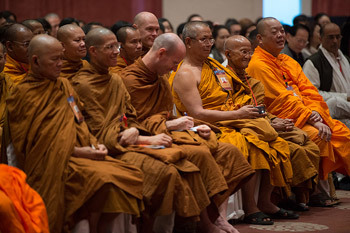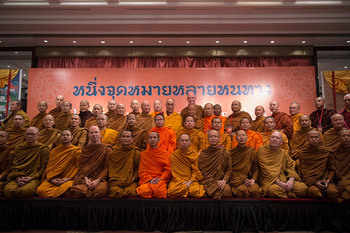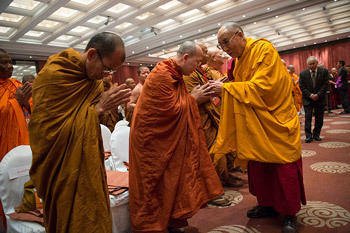New Delhi, India, 16 December 2012 - The large audience of Thai monks and lay-people, who filled the hall, were waiting eagerly for His Holiness the Dalai Lama’s arrival this morning. He greeted one and all with folded hands and asked them to sit. There followed a recitation in Pali of the Mangala Sutta at the end of which His Holiness too recited a short propitious verse and began to speak on the requested theme, “From Joining our Hearts to Joining our Hands.”
“Joining our hands can be destructive as when, for example, it involves military forces motivated by hatred of the enemy. That kind of joining hands in war has long been a part of human history. Indeed up to the Second World War citizens of the concerned countries joined up without hesitation. However, since the Vietnam War, this has changed and many US citizens refused to join the military.
“At the time of the Iraq conflict many people across the world protested. Many of the violent incidents that have taken place since the end of the twentieth century are due to and symptoms of past mistakes. So, today, here in the twenty-first century we have to join hands for peace, on the basis not of faith but of reason.”
His Holiness explained that when we resort to violence it creates fear, hatred and anger and in the long run leads to yet more violence. He gave the example of a barking dog, saying that if you threaten it with a stick it just barks more, but if day by day you give it something to eat and speak gently it will calm down and become tame. This is the nature of sentient beings.
He pointed out that in the past we might have been able to live comfortably in isolation, but this is no longer the case. Thailand is not alone in depending on other countries for a healthy economy and needs to maintain good relations with them. This is one of the reasons why violence and the use of force are so out of date. Instead, we need to join hands with a sense of global responsibility, aware of the oneness of humanity. His Holiness concluded light-heartedly,
“That’s all I have to say about this for now, but if you disagree I hope you’ll say so, because I’d value the opportunity to learn from you.”
A question was put to His Holiness about what practical steps will take the Tibetan-Thai Buddhist dialogue forward. He suggested that bhikshus, scholars and university professors would be very welcome to spend time at the Central Institute of Higher Tibetan Studies (CIHTS) also known as the Central University of Tibetan Studies in Sarnath, and as guests of Tibet House, New Delhi. They would be able to study and engage in further dialogue in both locations. He recalled that in the 1960s three Tibetan monks went to Thailand to study and participate in the Thai monastic way of life, one of them even taking ordination in the Thai tradition. Thereafter, not much happened. He suggested that to build on this renewed interest it would be helpful if a small group of Tibetans were to visit Thailand and a small group of Thais were to come to visit Tibetan institutions in India.

|
His Holiness the Dalai Lama speaking at the dialogue with Thai Buddhist scholars on "Reaching the Same Goal from Different Paths?" in New Delhi, India, on December 16, 2012. Photo/Tenzin Choejor/OHHDL
|
Noting that his relations with Christian brothers and sisters have in general been closer than with his fellow Buddhists from other countries, His Holiness suggested that this was due to misunderstandings. To illustrate this he recounted an occasion at a recent World Parliament of Religions in Australia when two Burmese Bhikshus asked to meet him. Having great admiration for Burmese Buddhism he said he was happy to do so. They told him that although both they and His Holiness followed the teachings of the same Buddha, they understood that there remained differences between them. He responded by telling them that not only do Tibetans follow the teachings of the same Buddha, but they also practise according to the same Vinaya. His Burmese visitors seemed both pleased and surprised.
“In the long run, we need to solve our language problems. I have already advised that the CIHTS in Sarnath should be an international centre of study where Pali and other related languages can be studied. We would welcome it if Thai scholars, female scholars too, could come to teach Pali and learn Tibetan. In our monasteries in South India, where at least 10,000 monks and nuns study, there are already students from Mongolia and other Asian countries. There are also Western monks, among them an American who has recently become abbot of one monastery.
“With regard to nuns, since the late 60s and early 70s I have urged our nunneries to offer dialectical studies for nuns and now, although we do not yet have the Bhikshuni ordination, we have decided to award nuns who qualify a Geshema doctorate. At the same time, preserving the Buddhadharma is not just about having good monks and nuns, but also educating lay-people. They too should develop a much better understanding.”
His Holiness went on to say that he is careful not to seem to be propagating Buddhism or seeking to convert others. He sees conversions as a potential source of conflict, something he has made clear to Christian missionaries he has encountered in Mongolia. He said we have to keep in mind today’s reality when people may be more sceptical about Buddhist ideas regarding past and future lives for example. He recommended that Buddhist teaching be relevant to life today.

|
Members of the audience listening to the discussion on "Reaching the Same Goal from Different Paths?" with His Holiness the Dalai Lama and Thai Buddhist scholars in New Delhi, India, on December 16, 2012. Photo/Tenzin Choejor/OHHDL
|
“Just as we teach about physical hygiene to ensure our bodies remain healthy, we also need to teach a mode of mental hygiene, discriminating between positive and destructive emotions and learning how to deal with them, to ensure that we have healthy minds.”
Asked how to encourage the young to become monks, His Holiness replied, “Education; educate the public, educate them about Buddhism.”
The Tibetan monastic scholars accompanying His Holiness were invited to add their views to the conversation and were as one in their support for this ongoing dialogue. Prof Samdhong Rinpoche also spoke about projects to translate Pali scriptures into Tibetan that had already begun, expressing a hope that they will be taken further.
The morning session was concluded with a Thai spokesperson reiterating the wish to join hands with Tibetans and engage in shared activities. Taking this meeting in the 2600th anniversary year of the Buddha as a propitious sign, he said they welcomed His Holiness’s advice regarding education and training and all those present affirmed this with a threefold recitation - “Sa-dhu.”
The final afternoon session began with one of the Thai monks saying that while he had come to appreciate that it would be more appropriate to refer to Tibetan and Thai Buddhism as “the same goal, same path,” the Mahayana praises the Bodhisattva ideal rather than the Arhat ideal. He asked how we should reconcile this difference. His Holiness explained that the Perfection of Wisdom Sutras of the Sanskrit tradition mention the Hearer Vehicle, the Solitary Buddha Vehicle and the Bodhisattva Vehicle (Sravakayana, Pratyekabuddhayana and the Bodhisattvayana), but that it would be a misunderstanding to see them as completely different.
He said that the aspiration for Nirvana is the very determination to be free that underlies the altruistic aspiration to lead others to freedom. The important thing is to shape our own minds. So long as we are under the sway of ignorance we will find no joy in cyclic existence. He pointed out that the Eightfold Noble Path is another way of presenting the Three Higher Trainings in ethics, concentration and wisdom. What is known as the First Turning of the Wheel of the Dharma deals with the Four Noble Truths, whereas the Second Turning elaborates on the Third Truth, cessation, and the Third Turning elaborates on the Fourth Truth, the path.

|
His Holiness the Dalai Lama with members of the Thai monastic community who attended the discussion on "Reaching the Same Goal from Different Paths?" in New Delhi, India, on December 16, 2012. Photo/Tenzin Choejor/OHHDL
|
His Holiness spoke of learning from a Chilean Quantum Physicist he met at a conference in Argentina, who explained how concerned he was not to become attached to his own scientific field for fear of becoming biased and unable to appreciate other fields with an open mind.
“I am a Buddhist, but I realised that I should not allow myself to become attached to Buddhism, which would obscure my ability to appreciate the value of other spiritual paths.”
Asked to offer some final words of advice, His Holiness said that he had been very impressed with the conduct of the dialogue. Everyone had been eager to engage in open discussion. He feels that the Buddha’s teachings are realistic and flexible. He recalled a German Neuroscientist, Wolf Singer, explaining that in the brain there is no central authority and remarking that this fits well with the Buddhist theory of anatma, or no-self or no-soul. Now in the twenty-first century we are faced with different realities, such as the findings of neuroscience, and while - as far as Vinaya is concerned - we have to be strict, in other ways Buddhism has the ability to contribute and adapt to such new realities.
















